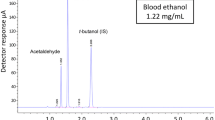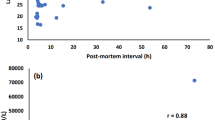Abstract
Purpose
Concentration ratio of ethanol/n-propanol has been employed to distinguish the source of ethanol in postmortem blood, though its reliability remains controversial.
Methods
Forty-two postmortem human blood samples with ethanol levels in the range of 0.07–4.64 mg/mL were investigated. Ethanol and n-propanol were determined by head-space gas chromatography coupled with flame ionization detection, while ethyl glucuronide (EtG) and ethyl sulfate (EtS) were determined by liquid chromatography–tandem mass spectrometry.
Results
EtG and EtS were both negative in 26% of the investigated postmortem blood samples and 11% of n-propanol-negative postmortem samples, indicating that n-propanol was not a reliable marker of putrefaction. It was also found that the ratio of ethanol/n-propanol (supposed to be < 20 without antemortem ethanol consumption) was unreliable by showing great individual differences and was opposite with the result of EtG and EtS in at least 17% of n-propanol-positive postmortem blood samples. Meanwhile, 140 antemortem blood samples were investigated, as an aid to estimate the blood alcohol concentration (BAC) at the time of death for postmortem samples with ethanol both from postmortem formation and antemortem consumption. By comparing with the maximum or minimum value of EtG and EtS concentration under certain BAC in antemortem samples, the BAC range at the moment of death could be estimated in 93% of postmortem samples.
Conclusions
The present study proved that n-propanol was not a reliable marker for either putrefaction or ethanol source distinction by showing considerable false rate.

Similar content being viewed by others
References
Girasek DC, Gielen AC, Smith GS (2002) Alcohol’s contribution to fatal injuries: a report on public perceptions. Ann Emerg Med 39:622–630
Snijder M, Calabria B, Dobbins T, Knight A, Shakeshaft A (2018) A need for tailored programs and policies to reduce rates of alcohol-related crimes for vulnerable communities and young people: an analysis of routinely collected police data. Alcohol Alcohol 53:578–585
Tindall J, Groombridge D, Wiggers J, Gillham K, Palmer D, Clinton-McHarg T, Lecathelinais C, Miller P (2016) Alcohol-related crime in city entertainment precincts: public perception and experience of alcohol-related crime and support for strategies to reduce such crime. Drug Alcohol Rev 35:263–272
Carfora A, Campobasso CP, Cassandro P, Petrella R, Borriello R (2018) Alcohol and drugs use among drivers injured in road accidents in Campania (Italy): a 8-year retrospective analysis. Forensic Sci Int 288:291–296
Gomez-Restrepo C, Gomez-Garcia MJ, Naranjo S, Rondon MA, Acosta-Hernandez AL (2014) Alcohol consumption as an incremental factor in health care costs for traffic accident victims: evidence in a medium sized Colombian city. Accid Anal Prev 73:269–273
Kelly AT, Mozayani A (2012) An overview of alcohol testing and interpretation in the 21st century. J Pharm Pract 25:30–36
Kugelberg FC, Jones AW (2007) Interpreting results of ethanol analysis in postmortem specimens: a review of the literature. Forensic Sci Int 165:10–29
Flanagan RJ, Connally G (2005) Interpretation of analytical toxicology results in life and at postmortem. Toxicol Rev 24:51–62
Leikin JB, Watson WA (2003) Post-mortem toxicology: what the dead can and cannot tell us. J Toxicol Clin Toxicol 41:47–56
Moriya F, Ishizu H (1994) Can microorganisms produce alcohol in body cavities of a living person?: a case report. J Forensic Sci 39:883–888
Hoiseth G, Karinen R, Christophersen A, Morland J (2010) Practical use of ethyl glucuronide and ethyl sulfate in postmortem cases as markers of antemortem alcohol ingestion. Int J Legal Med 124:143–148
Vezzoli S, Bernini M, De Ferrari F (2015) Ethyl glucuronide in vitreous humor and blood postmortem specimens: analysis by liquid chromatography–electrospray tandem mass spectrometry and interpreting results of neo-formation of ethanol. Ann Ist Super Sanita 51:19–27
Ziavrou K, Boumba VA, Vougiouklakis TG (2005) Insights into the origin of postmortem ethanol. Int J Toxicol 24:69–77
Krabseth H, Morland J, Hoiseth G (2014) Assistance of ethyl glucuronide and ethyl sulfate in the interpretation of postmortem ethanol findings. Int J Legal Med 128:765–770
Nanikawa R, Ameno K, Hashimoto Y, Hamada K (1982) Medicolegal studies on alcohol detected in dead bodies—alcohol levels in skeletal muscle. Forensic Sci Int 20:133–140
Nanikawa R, Kotoku S (1974) Medicolegal observations on a dead body drawn up from the sea bed, with special reference to ethanol and diatoms. Forensic Sci 3:225–232
Takayasu T, Ohshima T, Tanaka N, Maeda H, Kondo T, Nishigami J, Nagano T (1995) Postmortem degradation of administered ethanol-d6 and production of endogenous ethanol: experimental studies using rats and rabbits. Forensic Sci Int 76:129–140
Boumba VA, Economou V, Kourkoumelis N, Gousia P, Papadopoulou C, Vougiouklakis T (2012) Microbial ethanol production: experimental study and multivariate evaluation. Forensic Sci Int 215:189–198
Boumba VA, Kourkoumelis N, Gousia P, Economou V, Papadopoulou C, Vougiouklakis T (2013) Modeling microbial ethanol production by E. coli under aerobic/anaerobic conditions: applicability to real postmortem cases and to postmortem blood derived microbial cultures. Forensic Sci Int 232:191–198
Felby S, Nielsen E (1993) Postmortem blood alcohol concentration. Blutalkohol 30:244–250
Liang H, Kuang S, Guo L, Yu T, Rao Y (2016) Assessment of the role played by n-propanol found in postmortem blood in the discrimination between antemortem consumption and postmortem formation of ethanol using rats. J Forensic Sci 61:122–126
Hoiseth G, Karinen R, Christophersen AS, Olsen L, Normann PT, Morland J (2007) A study of ethyl glucuronide in post-mortem blood as a marker of ante-mortem ingestion of alcohol. Forensic Sci Int 165:41–45
Schloegl H, Rost T, Schmidt W, Wurst FM, Weinmann W (2006) Distribution of ethyl glucuronide in rib bone marrow, other tissues and body liquids as proof of alcohol consumption before death. Forensic Sci Int 156:213–218
Baranowski S, Serr A, Thierauf A, Weinmann W, Grosse PM, Wurst FM, Halter CC (2008) In vitro study of bacterial degradation of ethyl glucuronide and ethyl sulphate. Int J Leg Med 122:389–393
Hoiseth G, Karinen R, Johnsen L, Normann PT, Christophersen AS, Morland J (2008) Disappearance of ethyl glucuronide during heavy putrefaction. Forensic Sci Int 176:147–151
Hoiseth G, Kristoffersen L, Larssen B, Arnestad M, Hermansen NO, Morland J (2008) In vitro formation of ethanol in autopsy samples containing fluoride ions. Int J Leg Med 122:63–66
Halter CC, Laengin A, Al-Ahmad A, Wurst FM, Weinmann W, Kuemmerer K (2009) Assessment of the stability of the ethanol metabolite ethyl sulfate in standardised degradation tests. Forensic Sci Int 186:52–55
Hegstad S, Kristoffersen L, Liane VH, Spigset O (2017) EtG and EtS in autopsy blood samples with and without putrefaction using UPLC–MS-MS. J Anal Toxicol 41:107–113
Wang H, Li BX, Wang FL, Chang J, Zhang YF, Rao YL (2019) Determination of ethyl glucuronide and ethyl sulfate in human whole blood and vitreous humor by LC–MS/MS and applications to the interpretation of postmortem ethanol findings. J Anal Toxicol. https://doi.org/10.1093/jat/bkz082
Jones AW (2000) Medicolegal alcohol determination—blood- or breath-alcohol concentration? Forensic Sci Rev 12:23–47
O’Neal CL, Poklis A (1996) Postmortem production of ethanol and factors that influence interpretation: a critical review. Am J Forensic Med Pathol 17:8–20
Canfield DV, Kupiec T, Huffine E (1993) Postmortem alcohol production in fatal aircraft accidents. J Forensic Sci 38:914–917
Winek CL, Winek CL, Wahaba WW (1995) The role of trauma in postmortem blood alcohol determination. Forensic Sci Int 71:1–8
Cabarcos P, Alvarez I, Tabernero MJ, Bermejo AM (2015) Determination of direct alcohol markers: a review. Anal Bioanal Chem 407:4907–4925
Hoiseth G, Morini L, Polettini A, Christophersen A, Morland J (2009) Blood kinetics of ethyl glucuronide and ethyl sulphate in heavy drinkers during alcohol detoxification. Forensic Sci Int 188:52–56
Zhang X, Zheng F, Lin Z, Johansen SS, Yu T, Liu Y, Huang Z, Li J, Yan J, Rao Y (2017) Simultaneous determination of ethanol’s four types of non-oxidative metabolites in human whole blood by liquid chromatography tandem mass spectrometry. Anal Chim Acta 963:68–75
Sharma P, Bharat V, Murthy P (2015) Quantitation of ethyl glucuronide in serum and urine by gas chromatography–mass spectrometry. Indian J Med Res 141:75–80
Liu Y, Zhang X, Li J, Huang Z, Lin Z, Wang J, Zhang C, Rao Y (2018) Stability of ethyl glucuronide, ethyl sulfate, phosphatidylethanols and fatty acid ethyl esters in postmortem human blood. J Anal Toxicol 42:346–352
Helander A, Dahl H (2005) Urinary tract infection: a risk factor for false-negative urinary ethyl glucuronide but not ethyl sulfate in the detection of recent alcohol consumption. Clin Chem 51:1728–1730
Bosma PJ, Chowdhury JR, Bakker C, Gantla S, de Boer A, Oostra BA, Lindhout D, Tytgat GN, Jansen PL, Oude Elferink RP (1995) The genetic basis of the reduced expression of bilirubin UDP-glucuronosyltransferase 1 in Gilbert’s syndrome. N Eng J Med 333:1171–1175
Acknowledgements
This research was supported by Science and Technology Commission of Shanghai Municipality Technical Standards Special Projects (no. 17DZ22204100) and National Key R&D Program of China (no. 2017YFC0803504-2).
Author information
Authors and Affiliations
Corresponding author
Ethics declarations
Conflict of interest
The authors declare that they have no conflict of interest.
Ethical approval
Use of blood samples in this study was approved by Ethics Committee of School of Basic Medical Sciences, Fudan University.
Additional information
Publisher's Note
Springer Nature remains neutral with regard to jurisdictional claims in published maps and institutional affiliations.
Rights and permissions
About this article
Cite this article
Wang, H., Li, J., Huang, Z. et al. Assessment of the role played by n-propanol in distinction of ethanol source in postmortem blood with the assistance of ethyl glucuronide and ethyl sulfate. Forensic Toxicol 38, 195–202 (2020). https://doi.org/10.1007/s11419-019-00507-9
Received:
Accepted:
Published:
Issue Date:
DOI: https://doi.org/10.1007/s11419-019-00507-9




